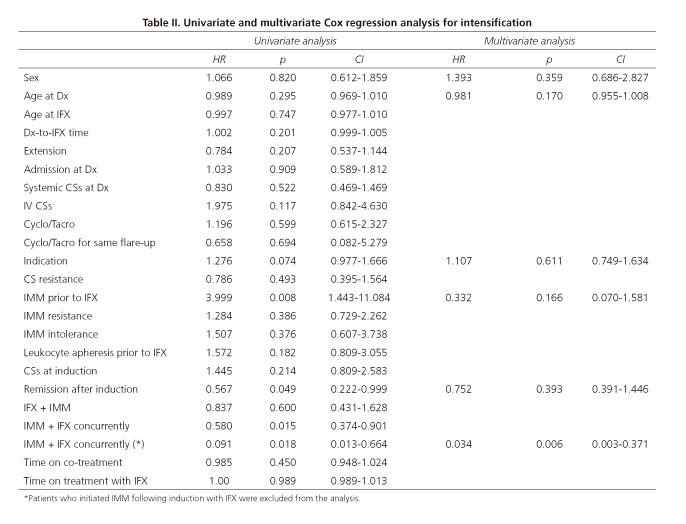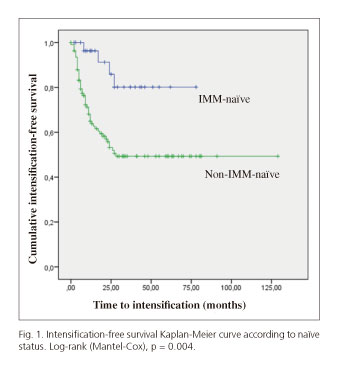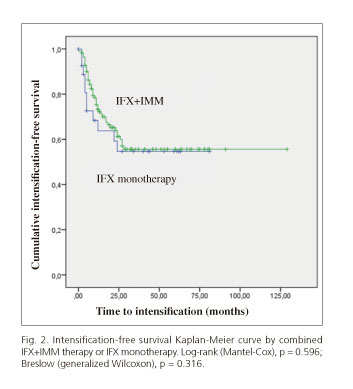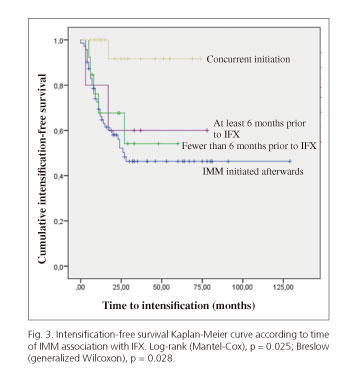Mi SciELO
Servicios Personalizados
Revista
Articulo
Indicadores
-
 Citado por SciELO
Citado por SciELO -
 Accesos
Accesos
Links relacionados
-
 Citado por Google
Citado por Google -
 Similares en
SciELO
Similares en
SciELO -
 Similares en Google
Similares en Google
Compartir
Revista Española de Enfermedades Digestivas
versión impresa ISSN 1130-0108
Rev. esp. enferm. dig. vol.107 no.9 Madrid sep. 2015
Frequency, predictors, and consequences of maintenance infliximab therapy intensification in ulcerative colitis
Frecuencia, factores predictores y consecuencias de la intensificación del tratamiento de mantenimiento con infliximab en la colitis ulcerosa
Luis Fernández-Salazar1, Jesús Barrio2, Fernando Muñoz3, Concepción Muñoz4, Ramón Pajares5, Montserrat Rivero6, Vanesa Prieto7, Jesús Legido8, Abdel Bouhmidi9, Maite Herranz10, Guillermo González-Redondo1, Nereida Fernández3, Fernando Santos2, Ramón Sánchez-Ocaña2, Diana Joao3 and ACAD (Asociación Castellana de Aparato Digestivo) Researchers
Department of Digestive Diseases.
1Hospital Clínico Universitario. Valladolid, Spain.
2 Hospital Universitario Río Hortega. Valladolid, Spain.
3 Complejo Asistencial Universitario. León, Spain.
4 Hospital Virgen de la Salud. Toledo, Spain.
5 Hospital Infanta Sofía. San Sebastián de los Reyes, Madrid. Spain.
6 Hospital Universitario Marqués de Valdecilla. Santander, Spain.
7 Complejo Asistencial Universitario. Salamanca, Spain.
8 Complejo Asistencial. Segovia, Spain.
9Hospital Santa Bárbara de Puertollano. Ciudad Real, Spain.
10 Complejo Asistencial. Ávila, Spain
ABSTRACT
Introduction: Infliximab (IFX) therapy intensification in ulcerative colitis (UC) is more common than established in pivotal studies.
Objectives: To establish the frequency and form of intensification for UC in clinical practice, as well as predictors, and to compare outcomes between intensified and non-intensified treatment.
Methods: A retrospective study of 10 hospitals and 144 patients with response to infliximab (IFX) induction. Predictive variables for intensification were analyzed using a Cox regression analysis. Outcome, loss of response to IFX, and colectomy were compared between intensified and non-intensified therapy.
Results: Follow-up time from induction to data collection: 38 months [interquartile range (IQR), 20-62]. Time on IFX therapy: 24 months (IQR, 10-44). In all, 37% of patients required intensification. Interval was shortened for 36 patients, dose was increased for 7, and 10 subjects received both. Concurrent thiopurine immunosuppressants (IMM) and IFX initiation was an independent predictor of intensification [Hazard ratio, 0.034; p, 0.006; CI, 0.003-0.371]. In patients on intensified therapy IFX discontinuation for loss of response (30.4% vs. 10.2%; p, 0.002), steroid reintroduction (35% vs. 18%; p, 0.018), and colectomy (22% vs. 6.4%; p, 0.011) were more common. Of patients on intensification, 17% returned to receiving 5 mg/kg every 8 weeks.
Conclusions: Intensification is common and occasionally reversible. IMM initiation at the time of induction with IFX predicts non-intensification. Intensification, while effective, is associated with poorer outcome.
Key words: Intensification. Optimization. Anti-TNF. Infliximab. Ulcerative colitis.
RESUMEN
Introducción: la intensificación del tratamiento con infliximab (IFX) en la colitis ulcerosa (CU) es más frecuente de lo establecido en estudios pivotales.
Objetivos: establecer la frecuencia y forma con la que intensificamos en CU en práctica clínica, los factores predictores y comparar la evolución entre los pacientes con tratamiento intensificado y no intensificado.
Métodos: estudio retrospectivo de 10 hospitales y 144 pacientes con respuesta a la inducción con IFX. Se analizaron variables predictoras de la intensificación con análisis de regresión de Cox. Se comparó la evolución, pérdida de respuesta a IFX y colectomía según tratamiento intensificado o no intensificado.
Resultados: tiempo de seguimiento desde la inducción hasta la recogida de datos: 38 meses [rango intercuartil (RIC) 20-62]. Tiempo de tratamiento con IFX: 24 meses (RIC, 10-44). El 37% de los pacientes requirió intensificación. Se acortó el intervalo en 36pacientes, se aumentó la dosis en 7, ambas en 10. La intro-ducción simultánea de inmunosupresores tiopurínicos (INM) e IFX predijo la intensificación de forma independiente [Hazard ratio (HR) 0,034 p 0,006 IC 0,003-0,371]. En los pacientes con tratamiento intensificado fue más frecuente la suspensión de IFX por pérdida de respuesta (30,4% vs. 10,2% p 0,002), la reintroducción de corticoides (35% vs. 18%, p 0,018) y la colectomía (22% vs. 6,4% p 0,011). El 17% de los pacientes intensificados volvió a recibir 5mg/kg cada 8 semanas.
Conclusiones: la intensificación es frecuente y en ocasiones reversible. La introducción del INM en el momento de la inducción con IFX predice la no intensificación. La intensificación, aunque eficaz, se asocia a una peor evolución.
Palabras clave: Intensificación. Optimización. antiTNF. Infliximab. Colitis ulcerosa.
Introduction
Infliximab (IFX) is an effective drug for the induction and maintenance of remission in ulcerative colitis (UC) (1). The standard regimen for maintenance consists of 5mg/kg every 8 weeks, but the need for dose increases or dose interval shortening as shown by pivotal studies (2) is lower than in clinical practice or real-world studies (3,4). Intensification is usually effective for IFX response recovery, thus avoiding therapy changes or colectomy (5-8), but has an impact on treatment cost (3) and perhaps patient safety. We intend to establish the frequency and form of maintenance IFX therapy intensification in patients with UC and loss of response to IFX, to identify intensification predictors, and to study efficacy and outcome for patients on intensified versus non-intensified therapy.
Material and methods
The ECIA (Estudio de Colitis e Infliximab de ACAD) is a retrospective, multicenter study performed in 10 hospitals at the autonomous regions of Cantabria, Castilla-La Mancha, Castilla y León, and Madrid under the sponsorship of Asociación Castellana de Aparato Digestivo. The study was approved by the Ethics Committee at Hospital Clínico Universitario, Valladolid (Spain). It included data from all UC patients treated with IFX from June 2003 to May 2014. Collected variables (Table I) included UC severity variables, treatments prior to IFX, co-treatment with IFX and thiopurine immunosuppressants (IMM), response to IFX, and outcome. Time from UC diagnosis to IFX induction, time on IFX, and (when appropriate) time from induction to intensification or de-intensification were also collected.
Use of corticosteroids, IMMs, cyclosporine or tacrolimus and leukocyte apheresis prior to IFX refers to their use at any point during the course of disease before IFX initiation. IMM resistance was defined as the need for IFX therapy despite a 6-month course of IMM at doses considered adequate by the treating physician because of titration according to weight or thiopurine methyltransferase. IMM discontinuation for intolerance was considered for unacceptable adverse events. As regards response to IFX induction, clinical remission was defined as symptom clearance plus CRP normalization following induction. Clinical response was defined as any clinical and/or laboratory improvement after induction that led to maintain IFX on grounds of its effectiveness. Patients where IFX was indicated for extraintestinal manifestations or pouchitis were excluded from the estimation of colectomy rates.
For this study 144 patients were selected who achieved remission or clinical response after standard-dose induction with IFX - 5 mg/kg at weeks 0, 2 and 6 with no intensification.
Quantitative variables were expressed as absolute and relative frequencies plus median and interquartile range (IQR). Qualitative variables were compared using the chi-squared test with Fisher's correction, and quantitative variables using the Mann-Whitney U-test. Predictors for the dependent variable "intensification" were analyzed using Cox's survival method. Hazard ratios (HR) and 95% confidence intervals were estimated for the following independent variables: Age at diagnosis, age at induction, sex, UC extension, need for systemic steroids at diagnosis, need for steroids at some point in the course of disease, IMM therapy prior to IFX, resistance to IMM, IMM intolerance and discontinuation, use of cyclosporine or tacrolimus at some point prior to IFX, use of cyclosporine or tacrolimus in the same flare-up as IFX, use of leukocyte apheresis at some point prior to IFX, IFX indication, time from diagnosis to IFX induction, use of steroids at induction with IFX, response or remission to induction, combined IFX plus IMM therapy, time of IMM addition to combined therapy, time on combined therapy, and time on IFX. Log-rank and Breslow tests were compared to intensification-free survival Kaplan-Meier curves according to prior IMM use, combined IFX plus IMM, and time to IMM initiation. Statistical significance was considered for p < 0.05.
Results
Follow-up was 38 months (IQR, 20-62) for all 144 patients from induction to data collection. IFX therapy duration was 24 months (IQR, 10-44) to data collection. Patient characteristics are summarized in Table I.
Intensification frequency and types
A total of 37% of patients received intensified therapy. Time from IFX induction to intensification was 9 months (5-15).
Thirty-six patients had shortened intervals and received 5 mg/kg every 6 weeks following 9.5 months (IQR 5-16) after induction. Seven patients were intensified by doubling their dose to 10 mg/kg every 8 weeks following 9 months (IQR 4-20) from induction. In addition, ten patients required double intensification (10 mg/kg every 6 weeks), with the first intensification occurring at 6 months (IQR 4-9) after induction. The total number of intensifications was 63. Intensification rate was 2.3 per 100 patients monthly.
De-intensification
Ten of the 36 patients with shortened intervals were de-intensified after 12 months (IQR, 4-16), and 3 of these were again re-intensified. Two of the seven patients with increased doses were de-intensified after 2 and 4 months, respectively. Two of the ten patients with double intensification were partially de-intensified by reducing doses to 5 mg/kg every 6 weeks, and after 2 and 24 months, respectively, were again re-intensified. In 26.4% (14/53) of patients with intensified therapy de-intensification was attempted, which could be sustained for 17% (9/53) to the end of follow-up.
Only 17% (9/53) of patients with intensified therapy were again treated with 5 mg/kg every 8 weeks. Treatment for 44 patients (83% of those with intensified therapy, 30.5% of total) remained intensified until IFX discontinuation or data collection, 10 of these being on double intensification. Therapies intensified at data collection had a duration of 12.5 months (IQR 3-40).
Factors predictive of intensification
A univariate survival analysis using Cox's model showed that the use of IMM before IFX (HR 3.999; CI, 1.443-11.084, p = 0.008), clinical remission after IFX induction (HR, 0.567; CI, 0.222-0.999; p = 0.049), and IMM therapy concurrent with IFX (HR, 0.580; CI, 0.374-0.901; p = 0.015) predicted intensification (Table II). As for the time of IMM association with IFX, intensification involved 49% when IMM was introduced 6 months or longer prior to IFX, 42% when IMM was introduced within 6months, 4.5% when both IMM and IFX were concurrently indicated, and 40% when IMM was introduced after IFX (p = 0.003). IMM introduction after IFX induction may have resulted from inadequate response to IFX, hence we decided to exclude from analysis all 5 patients who received IMM after IFX induction. A univariate analysis of this new variable was shown to also predict intensification (HR, 0.091; p = 0.018; CI, 0.013-0.664) (Table II).
In the multivariate analysis, the following independent variables were included: Age at induction with IFX, sex, IFX indication, IMM use prior to IFX, remission after induction, and time of IMM association with IFX, excluding patients where IMM was added after IFX induction. Time of IMM introduction for co-treatment was the only variable independently predicting intensification (HR, 0.034; p = 0.006; CI, 0.003-0.371) (Table II).
All 24 patients with concurrently introduced IFX and IMM exhibited additional differences from those receiving IMM either prior to or after IFX induction. In the concurrent IMM and IFX group 40% of IFX discontinuations were due to complete remission versus 10.7% (p = 0.054), and IFX treatment duration was shorter: 12 months (IQR, 6-26) vs. 26 months (IQR, 13-48), p = 0.005.
Kaplan-Meier survival curves show survival with no intensification according to prior use of IMM, concurrent IMM plus IFX, and time of IMM association with IFX (Figs. 1, 2 and 3).
Intensification outcomes
Intensification was associated with steroid reintroduction (35% vs. 18%; p = 0.018), IFX discontinuation for loss of response (30.4% vs. 10.1%; p = 0.002) and a higher colectomy rate (22% vs. 6.4%; p = 0.013), although adverse event rates were similar (14.3% vs. 20.5%). Therapy de-intensification was attempted for 14 patients, and could be sustained in 9. All 9 patients on de-intensified therapy had a lower loss-of-response rate (0% vs. 38.6%; p = 0.024) and colectomy rate (0% vs. 28.9%; p = 0.087), the latter without statistical significance, as compared to patients who remained on intensified therapy (Table III).
Discussion
Treatment intensification with anti-TNFα agents is crucial - for patients who lose their response this is, for the time being, the preferred option before changing to a different therapy such as anticalcineurin drugs, another biologic or colectomy. This intensification, necessary for the control of symptoms and of disease activity, entails high financial costs and likely risks for patients. This practice, now performed intuitively or according to experience, will change shortly when drug and antibody level measurements become of widespread use in hospitals. Regimens will likely become more flexible, and will differ depending on pharmacokinetics for each patient (9). In addition, the only option available for a therapy change was adalimumab, but the recent and upcoming availability of golimumab and vedolizumab, respectively, will also modify management in these situations, and the benefits and drawbacks of treatment intensification will be endorsed with more objective criteria.
In the extension of studies ACT I and ACT II 7% of patients receiving 5 mg/kg every 8 weeks were intensified to 10 mg/kg at the discretion of the investigator (1). This intensification rate is much lower than shown in other studies (1,3,6,10-12). In the study by Ferrante et al. nearly 40% of the 73 patients on maintenance with IFX were intensified (10), and a Spanish study also shows an intensification rate of 40% in the setting of UC (3). Other studies report a need for intensification of up to 70% (6). Also, 40% of children receiving 5 mg/kg every 8 weeks must be intensified (12). Intensification for UC occurs more commonly and earlier than for Crohn's disease (3). In our study only patients responding to usual induction doses -5 mg/kg in weeks 0, 2 and 6- were included, as we considered the inclusion of patients intensified at induction would detract from the study's homogeneity. Thus, we saw that during IFX therapy for 24 months almost 40% of patients received an intensified regimen for a mean of 12 months. Taxonera et al. (3) found an intensification rate of 3.9% monthly. Our monthly intensification rate is lower: 2.3% monthly, although the percentage of intensified patients is similar (36% vs. 42%) because time on IFX was longer for our patients: 24 months (10-44) vs. 13 months (8.1-23.3). On the other hand, 17% of patients on intensified therapy in our study underwent sustained de-intensification to the end of follow-up.
Regarding intensification, two options are commonly used, namely a shortening of dose intervals from 8 to 4 or 6 weeks (10), and a dose increase from 5 to 10 mg/kg per infusion. A shortened dose interval seems to be preferred, as is more common (6,10). Vahabnezhad et al. more commonly use dose increases for children, but consider a regimen of 5 mg/kg every 7 or 8 weeks as standard maintenance therapy (7). Effectiveness is similar for both types of intensification according to a retrospective study of 41 patients on intensified therapy (5).
The need for intensification represents the inadequacy of IFX for gaining disease control at conventional doses. Intensification predictors might be interpreted as predictors of loss of response. Severe colitis forms were identified as a predictor of intensification in a retrospective study of 80 patients on maintenance therapy (11). In our results indication did predict intensification in the univariate analysis, likely due to lower intensification needs when IFX was indicated for extraintestinal manifestations, but it was not an independent predictive variable. Otherwise, it seems only logical that the better the response to induction, the lower the need for intensification during maintenance therapy. We also see in the univariate analysis that remission predicts a lower need for intensification. IMMs likely influence response to IFX in a dual manner. On the one hand, IMM-naïve patients have been shown to exhibit higher clinical remission rates with IFX at 8 weeks (13), with steroid-dependent subjects displaying a lower risk for colectomy (14). On the other hand, combined therapy has a number of benefits over monotherapy. IMMs, when associated with IFX, reduce infusion-related reactions and immunogenicity (15), increase sustained clinical response rates (14), and reduce steroid needs versus IFX monotherapy (16). Anti-infliximab antibodies develop within the initial 12 months of treatment with IFX (17), and the association of IMMs during this period may preclude their emergence. According to our results, intensification occurs within 1.5 years. However, as other authors (11), we did not see lower intensification needs in patients with dual immunosuppression. As IMM naïvety and dual immunosuppression improve response to IFX, it seems obvious that patients starting IMM concurrently with IFX would be most favored. In fact, in our study, the simultaneous introduction of IMM and IFX predicts non-intensification and is associated with IFX discontinuation because of sustained remission or a change to IMM monotherapy in 40% of cases.
Intensification is effective for secondary loss of response; it allows a rapid recovery of response and remission in 90% and 46% of patients, respectively (5), and mucosal healing in 50% (8); it also may rescue patients from potential therapy changes and colectomy (5-7). In our study, patients with sustained intensified therapy discontinued IFX for loss of response in 40% of cases, and colectomy was necessary for 30%, with a mean follow-up slightly above 3 years from IFX induction; however, some authors report remissions in 85% of intensified patients with a follow-up of 5 years (6). Intensification is reversible, and de-intensification may be attempted -and is often successful- once response to IFX has been recovered. De-intensification was attempted in 14 of our patients, and was sustained until the end of follow-up in 9, which represents 17% of patients on intensified therapy. The reason for de-intensification was not a studied variable, but we consider it mostly due to IFX response recovery. These patients arguably have a better prognosis - patients would not have been de-intensified should their clinical status preclude it.
Our study is a retrospective one but includes a high number of patients recruited in 10 sites and treated over 10 years; it is also based on clinical practice and the decisions made by various physicians. The criteria for therapy intensification and its modality likely differ from one site to the next; while it reflects real-world clinical practice and is nearly unavoidable in retrospective studies, this fact detracts from the study's rigor. The potential for biases derived from the exclusion of some patients is possible but unlikely given their characteristics, the need for strict clinical follow-up, economic factors, and the specific focus of authors on inflammatory bowel disease.
We should consider the need for IFX therapy intensification in over one third of patients with UC; the duration of intensification remains unknown, but it may be reversed. Intensification does not seem avoidable except for IMM-naïve patients, with the association of IMM and IFX. The possibility of measuring anti-IFX antibody levels and the availability of other treatment options will change the scenario we are still in.
Conflicts of interest
No financial support or grant was used for the present study. L. Fernández-Salazar declares having received honoraria for research support from Abbvie, MSD, and Shire, as well as non-economic benefits from Ferring and Abbvie. F. Muñoz declares having received honoraria for research support from Abbvie and MSD. R. Pajares declares having received honoraria for research support from Almirall and Shire, as well as non-economic benefits from Abbvie. M. Rivero declares having received non-economic benefits from Abbvie and Ferring. V. Prieto decalares having received honoraria for reseacrh support and non-economic benefits from MSD and Abbvie. J. Legido declares having received honoraria for researcg support from Abbvie, as well as non-economic benefits from Abbvie, MSD and Shire. A. Bohumidi declares having received honoraria for research support from Abbvie, MSD and Shire.
References
1. Reinisch W, Sandborn WJ, Rutgeerts P, et al. Long-term infliximab maintenance therapy for ulcerative colitis: The ACT-1 and -2 extension studies. Inflamm Bowel Dis 2012;18:201-11. DOI: 10.1002/ibd.21697. [ Links ]
2. Rutgeerts P, Sandborn WJ, Feagan BG, et al. Infliximab for induction and maintenance therapy for ulcerative colitis. N Engl J Med 2005;353:2462-76. DOI: 10.1056/NEJMoa050516. [ Links ]
3. Taxonera C, Olivares D, Mendoza JL, et al. Need for infliximab dose intensification in Crohn's disease and ulcerative colitis. World J Gastroenterol 2014;20:9170-7. [ Links ]
4. Barreiro-de Acosta M, Lorenzo A, Mera J, et al. Mucosal healing and steroid-sparing associated with infliximab for steroid-dependent ulcerative colitis. J Crohns Colitis 2009;3:271-6. DOI: 10.1016/j.crohns.2009.06.003. [ Links ]
5. Cesarini M, Katsanos K, Papamichael K, et al. Dose optimization is effective in ulcerative colitis patients losing response to infliximab: A collaborative multicentre retrospective study. Dig Liver Dis 2014;46:135-9. DOI: 10.1016/j.dld.2013.10.007. [ Links ]
6. Yamada S, Yoshino T, Matsuura M, et al. Long-term efficacy of infliximab for refractory ulcerative colitis: Results from a single center experience. BMC Gastroenterol 2014;14:80. DOI: 10.1186/1471-230X-14-80. [ Links ]
7. Vahabnezhad E, Rabizadeh S, Dubinsky MC. A 10-year, single tertiary care center experience on the durability of infliximab in pediatric inflammatory bowel disease. Inflamm Bowel Dis 2014;20:606-13. DOI: 10.1097/MIB.0000000000000003. [ Links ]
8. Paul S, Del Tedesco E, Marotte H, et al. Therapeutic drug monitoring of infliximab and mucosal healing in inflammatory bowel disease: A prospective study. Inflamm Bowel Dis 2013;19:2568-76. DOI: 10.1097/MIB.0b013e3182a77b41. [ Links ]
9. Perez-Pitarch A, Ferriols-Lisart R, Alos-Alminana M, et al. A pharmacokinetic approach to model-guided design of infliximab schedules in ulcerative colitis patients. Rev Esp Enferm Dig 2015;107:137-42. [ Links ]
10. Ferrante M, Vermeire S, Fidder H, et al. Long-term outcome after infliximab for refractory ulcerative colitis. J Crohns Colitis 2008;2:219-25. DOI: 10.1016/j.crohns.2008.03.004. [ Links ]
11. Oussalah A, Evesque L, Laharie D, et al. A multicenter experience with infliximab for ulcerative colitis: Outcomes and predictors of response, optimization, colectomy, and hospitalization. Am J Gastroenterol 2010;105:2617-25. DOI: 10.1038/ajg.2010.345. [ Links ]
12. Hyams J, Damaraju L, Blank M, et al. Induction and maintenance therapy with infliximab for children with moderate to severe ulcerative colitis. Clin Gastroenterol Hepatol 2012;10:391-9. DOI: 10.1016/j.cgh.2011.11.026. [ Links ]
13. Lee KM, Jeen YT, Cho JY, et al. Efficacy, safety, and predictors of response to infliximab therapy for ulcerative colitis: A Korean multicenter retrospective study. J Gastroenterol Hepatol 2013;28:1829-33. DOI: 10.1111/jgh.12324. [ Links ]
14. Armuzzi A, Pugliese D, Danese S, et al. Long-term combination therapy with infliximab plus azathioprine predicts sustained steroid-free clinical benefit in steroid-dependent ulcerative colitis. Inflamm Bowel Dis 2014;20:1368-74. DOI: 10.1097/MIB.0000000000000115. [ Links ]
15. Lichtenstein GR, Diamond RH, Wagner CL, et al. Clinical trial: Benefits and risks of immunomodulators and maintenance infliximab for IBD-subgroup analyses across four randomized trials. Aliment Pharmacol Ther 2009;30:210-26. DOI: 10.1111/j.1365-2036.2009.04027.x. [ Links ]
16. Panaccione R, Ghosh S, Middleton S, et al. Combination therapy with infliximab and azathioprine is superior to monotherapy with either agent in ulcerative colitis. Gastroenterology 2014;146:392-400. DOI: 10.1053/j.gastro.2013.10.052. [ Links ]
17. Ungar B, Chowers Y, Yavzori M, et al. The temporal evolution of antidrug antibodies in patients with inflammatory bowel disease treated with infliximab. Gut 2014;63:1258-64. DOI: 10.1136/gutjnl-2013-305259. [ Links ]
![]() Correspondence:
Correspondence:
Luis Fernández Salazar.
Department of Digestive Diseases.
Hospital Clínico Universitario.
Avda. Ramón y Cajal, s/n.
47005 Valladolid, Spain
e-mail: luisfernsal@gmail.com
Received: 10-04-2015
Accepted: 28-05-2015











 texto en
texto en 








